|
Elle and Mel were packed to the hilt with food as we made our way through the Honeymoon Range to the north of the Tennant Creek shortly after eight o'clock in the morning. We soon knocked off the twenty two kilometres out to Three Ways, where the Barkly Highway from the east coast meets the Stuart Highway which links the north and south. At the roadhouse we added another four kilograms of water to the bikes and snapped the mandatory photo of the John Flynn memorial. It was too early for a cuppa so we carried on, planning to stop somewhere around the forty kilometre mark.
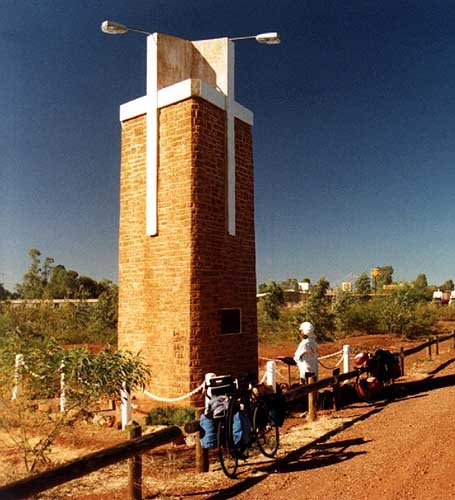
The John Flynn Memorial at Three Ways
As our cycle computers ticked over to forty, Karen spotted a caravan parked on the side of the road. Never backward in coming forward, she knocked on the door of the van and said to the people inside that if they just happened to have some boiling handy, she sure would appreciate it.
Bob and Carol from north Nowra, who were not boiling water at the time, went out of their way for us and invited us in for a cup of coffee and some biscuits. We spoke to them for over an hour! Much refreshed, and glad to have been able to escape the sun for a while, Karen and I soon punched out another thirty kilometres to arrive at our planned overnight stopping point at Attack Creek. It was here over one hundred years ago that Stuart, the explorer after whom the highway has been named, was attacked by a band of aborigines and forced to return south. The site is marked by a small stone monument, and an excellent parking bay complete with shade, water and tables. Rather than sit around for half the day however, Karen and I decided to push on.
The first ten kilometres after lunch were generally uphill. We finally reached a repeater station on top of a plateau, with views forever in almost every direction. It seemed like the whole Barkly Tableland was spread out before us. A long, wind-assisted downhill, with speeds of almost fifty kilometres per hour soon took us past one hundred kilometres for the day and had us looking for a likely camping site. We had passed a couple of creeks after lunch that had actually contained some water, and were hoping to find another. We eventually pulled off into a small and partially overgrown side-track, setting up camp well out of sight but still only about twenty metres from the highway.
During the night I had ample opportunity to reflect on the old joke about the Irishman who returned his air mattress to the camping store for a refund because it kept going down on him, when I discovered a severe leak in mine as well. It did not take long for the air to escape, and I slept the night on rocks, stones and the hard, hard ground.
The tailwind continued the following morning, a good solid south-easterly. Combined with the extra distance we had travelled the previous day, the wind soon brought us to Renner Springs, where we had originally planned to stay on our second night north of Tennant Creek. We arrived at 10:30am and spent a very unhurried morning tea at the roadhouse, taking a couple of photos of a huge flock of little Corellas sitting in a tree next to the highway, and meeting up with Yoichi, the Japanese motorcyclist from whom we had bought some beer in Alice Springs. While we had seen the MacDonnell Ranges and travelled to the beautiful Tennant Creek, Yoichi had ridden the Tanami Track and the Gibb River Road and toured Kakadu and visited Darwin and travelled around Litchfield. Not for the first time did we consider the benefits of motorised transport.
With the wind showing no signs of abating, Karen and I again decided to keep on cycling. We asked the barman at the pub about road conditions to the north, and whether there were any campsites between Renner Springs and the town of Elliot.
"No mate, no hope, the first forty kilometres is real hilly, there's fences both sides of the road, there's no creeks, nowhere to stop, once you leave here you'll have to go all the way to Elliot, and you wouldn't want to stop there..."
As it turned out, every piece of advice he gave us was wrong. As I have mentioned before, when someone gives you an opinion about the road surface ahead, or the weather to be expected, or the terrain to be encountered, that opinion has to be taken with a grain of salt. Karen and I always listen more closely to caravanners and other cyclists than we do to car drivers, simply because the former are affected by the conditions to a greater degree, and therefore notice more. Car drivers are cocooned in their own little environments where their interaction with the outside world is reduced to the single perception of sight. Sound, smell, touch and taste are all excluded from the metal, air-conditioned shell. A headwind or a hill is answered by an extra bit of pressure on the accelerator, and sometimes even that much interaction is cut off if the car is equipped with cruise control. Of course, caravanners have the same kinds of comforts, but wind and hills can dramatically degrade and affect the performance and safety of their cars and vans, so they tend to be more aware of their surroundings.
Pre-conceptions can also play a big part in the giving and receiving of advice and opinions. The barman was probably telling the truth, from his point of view. He undoubtedly drove a car, and if he camped at all it was probably in a parking bay, or a shady camping area beside a creek or billabong. For a car and a caravan, there would have been no place to stop, but we do not need much room, just a clear, flat area out of sight of the road. For a bike and a tent, there were a thousand places to camp. He was right when he said there were fences on both sides of the road, but they were not present all of the time. There were quite lengthy stretches where one of the fence-lines was missing, and sometimes both. He was also right about the country being hilly. The terrain we had traversed to get to Renner Springs was pretty flat, so in comparison the next forty kilometres of road north of the roadhouse really was hilly - it had two hills!
Karen and I rode out of Renner Springs knowing that the ninety odd kilometres to Elliot would give us our longest day of riding, and hoping like hell that the tailwind stayed with us. It did, but even so it was almost five in the evening when we finally stopped riding after a day of one hundred and thirty eight kilometres. A couple of noteworthy incidents occurred during the day.
The country had been fairly scrubby, but around lunchtime a big, shade tree materialised on the side of the road and said Welcome. Little did we know that we were about to experience the lunch-stop from Hell. The tree provided shade for squadrons of kamikaze flies, all waiting patiently to attack anything that strayed into their territory. I thought back to the four flies that had used Karen's coffee cup for a swimming pool earlier in the trip as I extracted another four similar flies from my can of sardines. I did not attempt to eat any more food, but Karen persisted with jam and peanut butter on crackers, a sticky concoction that sent the flies into delirium. It takes much more than a few gooey flies to put Karen off her food!. She calmly removed any fly which became mired in her lunch, and carried on regardless.
As we rode into Elliot we were greeted by a special welcoming committee of about ten mongrel dogs, mostly cross breeds. If I had connected with the pump I was swinging at the bastards as they ran along beside us, a few of them would have been even more cross! We set up at the caravan park, and while Karen fixed dinner, I inflated my thermarest and dunked it in the swimming pool. A tell-tale stream of bubbles rose from a small hole near the valve. I put a patch over the hole and was pleasantly surprised when the mattress stayed inflated during the night.
After a day of one hundred and thirty eight kilometres we needed plenty of rest, so the next morning we slept in until 7:30am. This day would be a 'short' day of only one hundred kilometres. How blasť about distances we had become.
We bid goodbye to a couple of Victorian lads we had spoken with over dinner the previous night. They too were travelling up through the centre, and they would be retracing our ride down the east coast before returning to Melbourne. They would complete the circuit in three weeks - it would probably take us an entire year.
Like the long, heavy days out of Alice Springs, the days from Tennant Creek were also taking their toll on Karen and me. We both felt rather listless as we ground out the kilometres between Elliot and the next roadhouse up the track, but we put in the hours and completed our third consecutive one hundred kilometre day. This was only the third time we had accomplished this feat, the others being Yeppoon to Mackay in the previous year, and more recently, Woomera to Coober Pedy. It was not, however, a feat we wanted to achieve too often.
As we progressed northwards, the trees had gradually been getting taller and the ground plants thicker. Due to the flatness of the terrain, we were now riding through a green tunnel, unable to see anything but the road and its immediate surrounds. None of this was particularly inspiring, and in the future we would look back on this part of the trip with little enthusiasm. We were simply packing away the kilometres so we could get to the next dot on the map, which happened to be the Dunmarra roadhouse.
It was almost four in the afternoon when we rolled into the driveway of the roadhouse. We were greeted outside the entrance by a female employee who demanded to know what had taken us so long. Keith and Elaine, she informed us, had passed through almost three weeks before. It took Karen and I a moment to realise that we were talking to Elaine, from John and Elaine fame, the couple we had met at the Ellery Creek Big Hole. Elaine had experience in the fast food industry and had taken a job behind the counter while her husband John, a carpenter, was doing renovations around the roadhouse for about six weeks before moving on. They invited us to dinner at their portable house, and we enjoyed their company until late - 10pm.
With only a very short ride planned for the next day - about fifty kilometres - Karen and I spent the next morning looking for birds around the roadhouse in general, and in John and Elaine's front yard in particular. The pickings were exceptionally rich, with Rufous-throated and Grey-fronted Honeyeaters, Great Bowerbirds, double-barred, zebra and long tailed finches, apostle birds, budgies and cockatiels, and even pelicans, straw necked ibises and white necked storks.
A conversation with a single female traveller proved to be a rather salutary lesson for Karen and me. The woman had originally left home with the intention of travelling around Australia for an entire year, but with the passage of time she had found that she missed her daughters too much and was now returning to be with her family. While this may seem understandable, it should be noted that she was forty-ish, her daughters were presumably grown up, and she had only been separated from them for two weeks!
Fifty three kilometres took us to Daly Waters through country that continued to be flat and viewless. We visited the aerodrome - Australia's first international airport - and Stuart's Tree which supposedly had the explorer's initials carved into it (we never found them) before riding to the main attraction of the town - the Daly Waters pub, reputed to be the Northern Territory's oldest hotel. Karen and I shared a pint, went for a swim in the pub's pool and spent the rest of the day relaxing and doing all the normal evening activities - like reading, writing up the diary, doing a cryptic crossword, cooking, eating dinner and cleaning up afterwards.
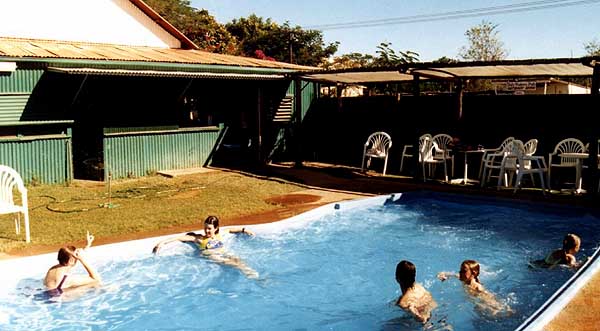
The pool at the Daly Waters pub
The country continued to consist of uninspiring eucalypts the following day. Sparser than the day before, the trees were now surrounded by a covering of long grass which blinkered our view of any sights which might have existed away from the highway. The flatness of the terrain was relieved by a few undulations - big deal - while the long, straight sections had given way to a series of meanders. Combined with the lack of visibility due to the trees, the curves gave roadtrain drivers little time to react to our presence, so they were no longer giving us a lot of room. We exited the road a couple of times during the day, discretion being the better part of valour as the roadtrains thundered by.
How boring was this stretch of road? Well, it was so boring that Karen begged me to give her some ideas that she could think about. At the time she made her request, I was so bored that my mind had wandered off to another world entirely where I was busy formulating the philosophy and policies of an entirely new Australian political party that I would like to establish one day. That is how boring the riding was!
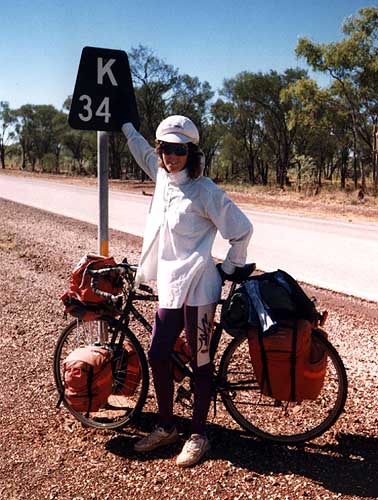
340 kms from Katherine (Karen was 34 at the time)
Four and a half hours of riding over ninety three kilometres brought us to Larrimah. We lunched at its historic hotel which had been used as an officer's mess during the second World War, but despite free camping at the pub (two dollars for a shower) we camped at the caravan park across the road for an extra dollar each. The extravagance of our accommodation was more than compensated for by the swimming pool, the laundry, the tables and chairs, and the peacocks, bird aviary and four metre crocodile, the latter safely ensconced inside a wire enclosure.
Shortly after we set up our tent, a car pulled up nearby and its woman driver got out and began setting up her campsite as well. The camping area was huge, but the woman chose to put her tent right next to ours. Imagine an area the size of a cricket field and picture two tents pitched within ten feet of each other near the edge of it. That is what it was like. After setting up her tent, the woman opened the back door of the car and brought out two dogs, quickly chaining them to a nearby tree. My diary entries for that night and for the next morning show how disgusted I was with her violation of our personal space.
"We had dinner in the roadhouse, so avoiding a woman and her whining little brat, her Weimarainer and her Jack Russell terrier, who, with the entire park to choose from, set up her tent almost on top of ours..."
"... with much slamming of doors and shooshing of the brat, the lady next door was up and packing at 5:30am and left by 6... some people don't deserve to be travelling with kids and dogs, but she does..."
Having been awakened so early, Karen and I rose just before dawn to watch the sun rise through the misty forest around us. While it might sound lovely, the mist meant we had to pack up a wet tent. A day just like yesterday in distance and terrain ensued, only made distinctive in our memory when Karen "charmed" some boiling water from two caravanners for our cuppas at morning tea time, and by the sighting of Brolgas, Jabirus and white-necked herons from the bridge over Warloch Ponds halfway through the day.
At sixty three kilometres we passed the turn-off to the Elsey Cemetery, which held the graves of people made famous by the classic Australian novel "We of the Never Never" by Aenaus Gunn. I was sure when I had visited the cemetery on my round Australia motorcycle trip in 1975 that it had been located adjacent to the highway, but a sign now indicated it was some eight kilometres distant. I doubted my memory for quite a while until I found out that the road had been re-aligned sometime during the intervening twenty years.
Twelve more kilometres brought us to Mataranka. At first we were not too impressed by the scattered groups of aborigines sitting in the park in the middle of the main street, apparently doing very little except yelling at each other. However, a quick trip to the supermarket made us reverse our opinion of the town. There we learned that four and five litre wine casks were available for sale, that it only takes one person and not four to buy a slab of beer, and that metho is displayed on the supermarket shelves, in full public view! We had ridden almost two thousand kilometres through the Northern Territory without finding a town or roadhouse where all three of these criteria applied. Mataranka is indeed a civilised town!
Karen and I shopped, lunched and then rode eighteen kilometres out to a campground at the Elsey national park. We had been riding for six straight days since Tennant Creek and had smashed our previous best six day total by eighty kilometres, setting a new record of five hundred and ninety five kilometres which would remain unbroken during the rest of our travels.
We stayed at the national park for three nights, spending two complete rest days by the Roper River. We explored the park, swam often and generally recharged our batteries in readiness for further riding. The flora and fauna of the park reminded us of Lawn Hill, a comparatively close seven hundred kilometres away to east. Elsey was also home to the red-collared Lorikeets, Great Bowerbirds and Crimson Finches which had been so common at Lawn Hill. In addition, both national parks sported highly mineralised rivers with tufa dams forming low waterfalls. The riverine vegetation was very similar as well, with pandanus and cabbage tree palms close to the water's edge.
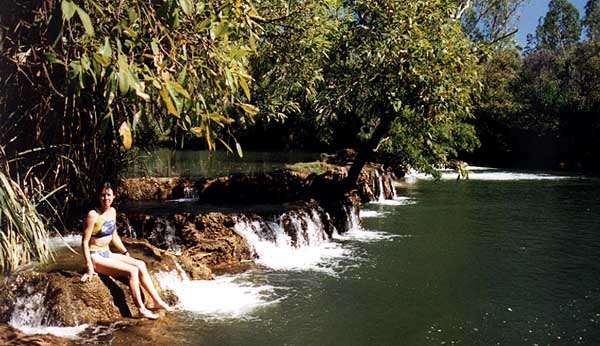
Karen at the Roper River
Our first night at Elsey national park was punctuated by one of the weirdest and most unexpected sounds we ever heard - the braying of wild donkeys. Not only was the noise awful, but it was also accompanied by the sounds of hoof beats and breaking bushes as the donkeys charged around after each other in the scrub. It is an unpleasant feeling to be lying in your tent at night, half expecting a large, wild animal to come blundering along to trample you to death at any moment.
In 1995 the courtship display of the Great Bowerbird had been our "Highlight of the Year". While we were at Elsey national park we witnessed a major contender for the 1996 award. While it is probably not on the list of must-see events for normal people, for birders like us it was spectacular. Karen and I saw a Mistletoebird have a shit! Is that a stunned silence I can hear out there? Let me explain.
Mistletoe birds are tiny, one of Australia's smallest birds. The male has the brighter plumage, as is usual with most birds, with jet black wings and head, a bright red breast which fades into white underparts, and a black line from throat to belly button. (Do birds have belly buttons?). The female of the species is a dullish brown, its only real adornment being orange-pink bars under its tail. As their name implies, Mistletoebirds are associated with mistletoe, the parasitic plant that can be seen hanging in clumps on host trees right around Australia. Wherever there is mistletoe, there are probably Mistletoebirds, because they are reputed to be almost solely responsible for the promulgation of mistletoe seeds, and therefore the propagation of the plant. Other birds may eat mistletoe seeds, but none of them shit quite like a Mistletoebird!
Karen and I had walked down to Mataranka Falls for a swim and some photos, and were on our way back to camp when we saw a small bird fly into a tree just above us. We both glassed the bird and quickly realised that it was a Mistletoe Bird, but while we were watching, it went into its motions, so to speak. The relationship between Mistletoe Birds and mistletoe is a wondrous thing. Where other birds eat, digest and pass mistletoe seeds without a problem, the Mistletoe Bird only partially digests the seed, its major source of food. It then tries to expel the partially digested seed from its body, but a bright yellow glue which covers the seed prevents it from dropping. To facilitate the seed's removal, the Mistletoebird wipes its bum on the branch it is standing on. The seed sticks to the bark, germinates, sends roots into the tree to tap the nutrients in its sap, and soon grows into a fully mature mistletoe, ready to produce another crop of seeds for hungry little Mistletoe Birds to eat. And so the cycle goes on. To actually see a Mistletoe Bird deposit a seed was breathtaking, though the sight of such a small bird passing such a large seed almost brought tears to our eyes.
With two days of rest and recreation behind us, Karen and I made the short hop - nineteen kilometres - from the Elsey national park to the famous thermal springs of Mataranka. We joined the throng in the thermal pool, investigated Rainbow Springs, the source of the heated water, and then made our way to the Elsey Homestead - a replica built for the filming of "We of the Never Never" a few years before. A video screen had been set up on the verandah of the homestead, with viewings of the movie each day at noon, and like good little tourists we did as the Romans do and dutifully watched the show. It was hardly Academy Award material, but a pleasant diversion nonetheless.
The camping area at the resort was huge, and most of it was occupied, so we hitched up Elle and Mel and rode back to a "free" campsite a few kilometres away by the Little Roper River. The following morning we were up bright and early, a good south-easterly breeze convincing us that we could reach the town of Katherine by the end of the day.
Shortly after we began riding we spotted a familiar van approaching. It slowed down, stopped and then flashed its headlights. It was Keith and Elaine, who had transported us around Ayer's Rock, the Olgas and King's Canyon! They should have been a month in front of us by now, heading down the Western Australian coast, so we were astonished to see them still in the Northern Territory and travelling in the wrong direction.
We soon learned that they had travelled to Darwin, around Kakadu, and then continued on into Western Australia, still in the company of Harry and Edna. While the latter had decided to continue on to Perth and then complete the round Australia trip, Keith and Elaine had turned around at Wyndham and headed for home.
We were amazed at the coincidence of meeting them again. If they had passed by a day later we would have been in Katherine and they never would have found us. If they had passed by on any of the previous four days when we were camped at Elsey National Park, we would not have met them again either. Again, as in the past, our meeting seemed to be ordained by a higher authority.
After promising to stay in touch, we each went our separate ways. The wind direction remained kind, so we ignored the boring scenery and pushed onwards, reaching Katherine at four in the afternoon after a day of one hundred and fifteen kilometres. We then cycled another nine kilometres out of town to the cheapest caravan park in the area - Springvale Homestead. It was a good choice. It turned out to be one of the best caravan parks we ever stayed at.
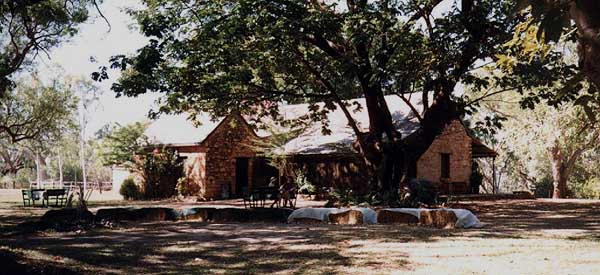
Springvale Homestead
From the time we had left Port Augusta, Karen and I had been travelling through desert country with very few rivers. Those we had seen - like the Todd in Alice Springs - were dry. The Roper River had been the first flowing river we had seen in over three thousand kilometres. The desert was now behind us. Until we reached Darwin, the one feature common to all of our overnight stops would be water.
|




